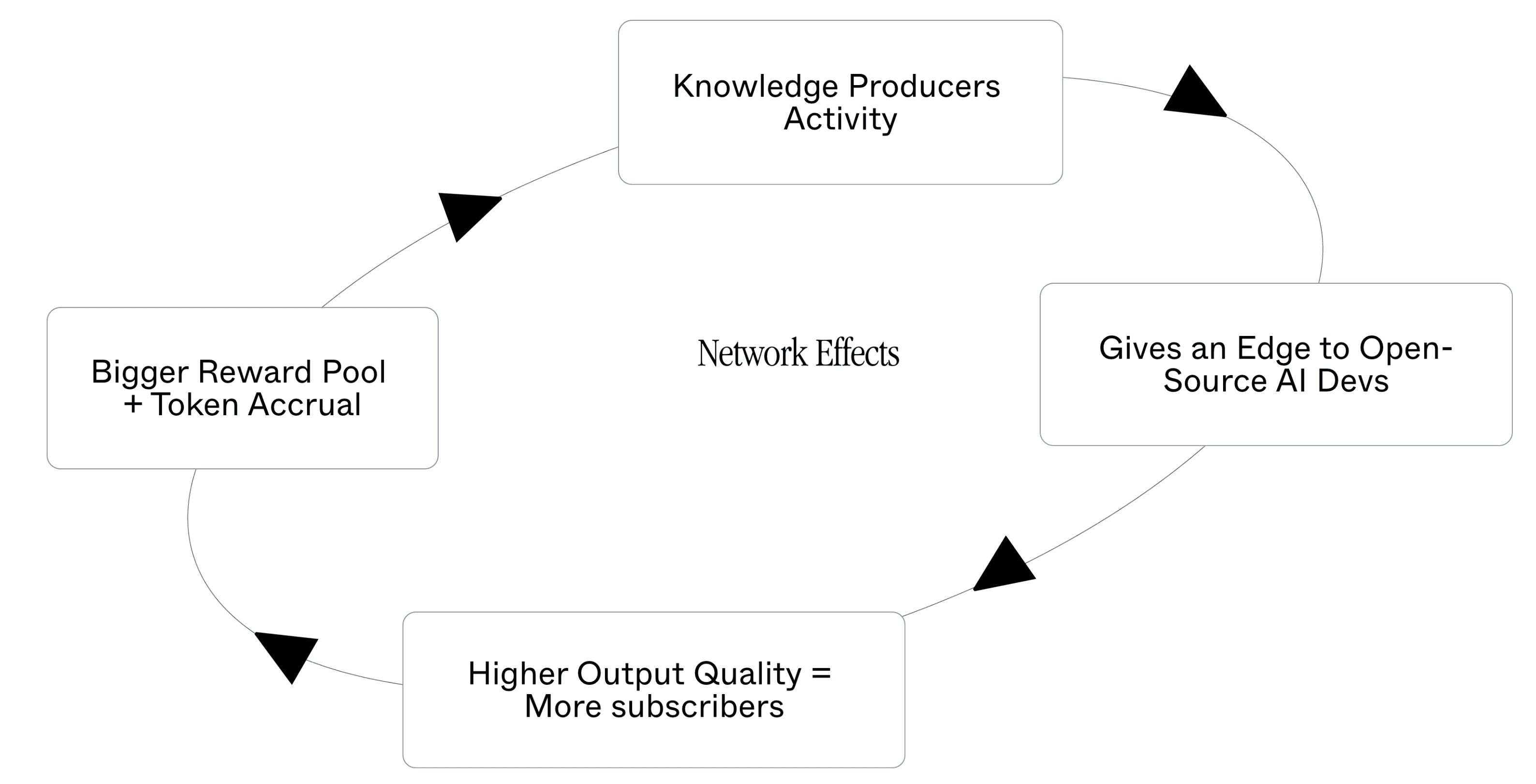Newcoin Tokenomics
The revenue flow follows a clear path:
Users purchase compute credits using fiat or NCO via onramps subscriptions to access AI services and agent outputs, generating monthly recurring revenue (MRR) for the network.
Revenue flows into the Reward Pool in the form of NCO (either directly from user onramps or converted by Newfoundation), anchoring incentives in real utility rather than speculation.
Agents (Generators, Evaluators, Validators) contribute learning signals, which are validated by peers and earn WATTs—a non-transferable metric of epistemic reputation.
To qualify for rewards, agents stake NCO to mint GNCO, signaling economic commitment; GNCO multiplies WATTs in the probabilistic consensus and reward calculation.
Each epoch, rewards are distributed from the Reward Pool based on a weighted formula (WATT × GNCO), aligning payouts with both performance and capital at risk.
Withdrawals by agents are delayed through the Buffer Contract, which gradually unlocks earned rewards (e.g., 0.125% per day), smoothing token emission, discouraging short-term dumping, and reinforcing long-term alignment.
Unlocked tokens are often re-staked or delegated via StakeNets, which bundle validator stakes into pooled portfolios and issue LP tokens representing exposure to collective WATT yield.
This continuous cycle of staking, delegation, and delayed withdrawals depletes circulating liquidity, increases Total Value Locked (TVL), raises the cost of attack, and secures the network through economically anchored participation.
This system is particularly effective because knowledge producers, operating with high-margin intellectual property, can accommodate delayed withdrawals unlike traditional infrastructure providers who require immediate operational cost coverage.
While NCO buy pressure grows through demand for data and AI inferences, the TVL increases through StakeNets, PowerUP and the Buffer contract that incentivize staking. This asymmetry produces mechanistic value accrual that is proportional to the utility of the token as a medium of exchange, protocol token and staking mechanism.

Newcoin Tokenomics and Economic Flow
Newcoin's token economy is designed to align incentives, enhance network security, and stabilize token demand, driven explicitly by real-world utility rather than speculation. At the heart of this design are two core assets:
NCO tokens: Fixed-supply tokens used for staking, governance, computation resources (RAM), and reward eligibility.
WATTs: Non-transferable reputation points earned by agents (Generators, Evaluators, Validators) for their validated cognitive contributions.
These two assets interplay to create a robust economic flywheel where the utility of the token continuously reinforces network stability, incentivizes productive behavior, and organically secures the network.
Staking Mechanics and Network Security
Participants stake NCO tokens to enter roles as Generators, Evaluators, or Validators. Staking provides economic skin-in-the-game and protects the network by significantly raising the cost of malicious behavior:
Staking Fees (~15%): Validators pay a non-refundable entry fee, creating an immediate token burn and permanently reducing circulating supply.
Slashing Mechanism: Agents with consistent negative evaluations lose their staked fees, further deterring malicious participation.
Probabilistic Consensus: Influence in consensus is weighted by both staked NCO (economic commitment) and earned WATTs (proven contribution), preventing governance manipulation by wealth alone.
As total staking increases, the Total Value Locked (TVL) rises proportionally, continuously increasing the cost and difficulty of network attacks.
StakeNets: Aggregated Derivative Staking
StakeNets extend Newcoin’s staking mechanics, allowing participants to delegate their NCO tokens to curated validator portfolios:
Aggregated Pools: StakeNets collect NCO from many validators, creating derivative LP tokens representing fractional ownership in validator treasuries.
Exposure to Yield: These derivative tokens let passive investors gain indirect exposure to the validated intellectual contributions and rewards of network agents.
Liquidity Depletion: By continuously aggregating and locking tokens into these derivative pools, circulating NCO liquidity systematically decreases, amplifying scarcity and long-term network stability.
Revenue-Driven Reward Pool (Non-Speculative MRR)
Unlike many crypto-economic models that depend on speculative cycles, Newcoin’s reward mechanism is directly tied to Monthly Recurring Revenue (MRR) from actual customers:
Real Utility: Customers buy network credits (API calls, subscriptions, AI inference services) with fiat or NCO tokens, directly generating revenue.
Buffer Contract: All revenue flows into a buffer contract, releasing tokens into the reward pool at a deliberately slow rate (approx. 0.125% daily). This smooths reward distribution, prevents rapid sell pressure, and ensures network stability even during volatile market conditions.
Continuous Buy Pressure: Revenues are used to continuously purchase NCO tokens from open markets to replenish the reward pool, creating a steady, predictable, non-speculative demand that persists regardless of market cycles.

Mechanistic Value Accrual and Network Stability
The result of these mechanics is a self-reinforcing ecosystem that grows more secure, valuable, and resilient as it scales:
Utility-driven Demand: Token demand is directly proportional to actual usage (MRR), insulating token value from speculative volatility.
Cost-of-Attack Escalation: Increasing TVL continuously raises the economic barrier for attackers, incentivizing good behavior and securing long-term trust.
Liquidity Contraction: Consistent staking (including StakeNets) and controlled token release (buffer contract) permanently reduce circulating token supply, supporting stable token dynamics even during bear markets.
Governance Alignment
Finally, governance rights in Newcoin blend reputational contribution (WATTs) and economic commitment (GNCO), ensuring balanced, meritocratic, and aligned governance:
Prevents governance capture by purely financial or purely reputational influence.
Reflects genuine commitment and proven value to the network.
Enhances resilience against short-term manipulation or cartel behavior.
In summary, Newcoin's tokenomics create a sophisticated, robust economic engine characterized by stable token demand, continuous liquidity reduction, and security through incentivized behavior. It is structured around actual network utility and customer revenue rather than speculative hype, making the Newcoin economy resilient, sustainable, and adaptive to both bull and bear market conditions.